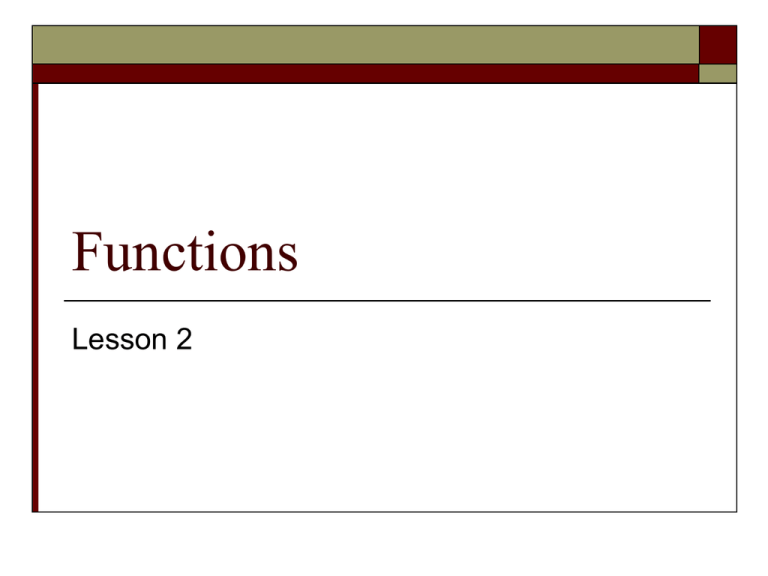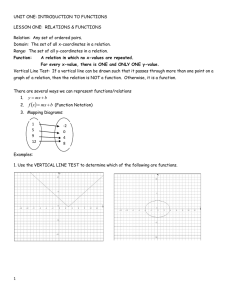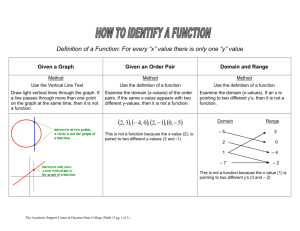Lesson 2 - Functions
advertisement

Functions
Lesson 2
Warm Up
1. Write an equation of the line that passes
through the points (-2, 1) and (3, 2).
x 5y 7 0
2. Find the gradient of the line that is
perpendicular to the line 4x – 7y = 12.
7
m
4
3. Write the equation of the vertical line that
passes through the point (3, 2).
x3
Relation
Relation – pairs of quantities that are related
to each other
Example: The area A of a circle is related to
its radius r by the formula
A r .
2
Function
There are different kinds of relations.
When a relation matches each item from one
set with exactly one item from a different set
the relation is called a function.
Definition of a Function
A function is a relationship between two
variables such that each value of the first
variable is paired with exactly one value of
the second variable.
The domain is the set of permitted x values.
The range is the set of found values of y.
These will be called images.
Let’s take a look at the function that relates
the time of day to the temperature.
Rules to be a Function
Is it a Function?
For each x, there is
only one value of y.
Therefore, it IS a
function.
Domain, x
1
2
3
4
5
6
52
Range, y
-3.6
-3.6
4.2
4.2
10.7
12.1
52
Is it a function?
Three different yvalues (7, 8, and 10)
are paired with one xvalue.
Therefore, it is NOT a
function
Domain, x
3
3
3
4
10
11
52
Range, y
7
8
10
42
34
18
52
Function?
Is it a function? Name the domain and range.
{(3, -5), (4, -8), (5, 6), (7, 10), (8, 2)}
YES. For every x-value, there is only one
value of y.
Domain: (3, 4, 5, 7, 8)
Range: (-5, -8, 6, 10, 2)
Function?
Is it a function? State the domain and range.
{(5, 8), (6, 7), (3, -1), (4, 2), (5, 9), (12, -2)
No. The x-value of 5 is paired with two
different y-values.
Domain: (5, 6, 3, 4, 12)
Range: (8, 7, -1, 2, 9, -2)
Function?
Is it a function? Name the domain and range.
{(-2, 3), (4, 6), (3, 1), (7, 6), (9, -3), (2, 8)}
Yes. For every x-value, there is only one
value of y.
Domain: (-2, 4, 3, 7, 9, 2)
Range: (3, 6, 1, -3, 8)
Function?
YES
Vertical Line Test
Used to determine if a graph is a function.
If a vertical line intersects the graph at more
than one point, then the graph is NOT a
function.
NOT a function
IS a function
You Try…...
You Try….
You Try: Is it a Function?
YES
You Try…Is it a function?
YES.
You Try…Is it a Function?
NO.
Is it a function? Give the domain and range.
FUNCTION
Domain : 4,2
Range : 4,4
Give the Domain and Range.
Domain : x 1
Range : y 2
Domain : 2 x 2
Range : 0 y 3
IB Notation….
When a function is defined for all real values,
we write the domain of f as
Functional Notation
We have seen an equation written in the form
y = some expression in x.
Another way of writing this is to use
functional notation.
For Example, you could write y = x²
as f(x) = x².
Functional Notation
f(x) = 3x + 5
Find:
f (2)
3 2 5
65
1
f (0)
f (5)
30 5
35 5
05
15 5
5
20
Functional Notation
f ( x) 3 x x 2
2
Find:
f (3)
3 3 3 2
27 3 2
30 2
32
2
f (0)
f (4)
30 0 2
002
34 4 2
316 4 2
48 4 2
46
2
2
2
Functional Notation
f ( x) x x 2
2
Find:
f (m)
m m2
2
f ( m 3)
m 3 m 3 2
m 3m 3 m 3 2
2
m 2 3m 3m 9 m 3 2
m 5m 8
2
Let’s look at Functions
Graphically
f ( 2) g ( 4)
Find:
f ( x)
g ( x)
Find:
f ( 1) g ( 0)
f ( x)
g ( x)
Find:
f ( 2) g ( 1)
f ( x)
g ( x)
f (5) g (0)
Find:
f ( x)
g ( x)
Find:
f ( 4) g ( 1)
f ( x)
g ( x)
Find:
f ( 4 ) g ( 2 )
f ( x)
g ( x)
Find:
f ( 2) g (0)
f ( x)
g ( x)
Find:
g (5) f ( 3)
f ( x)
g ( x)
Piecewise-Defined Function
A piecewise-defined function is a function that is
defined by two or more equations over a specified
domain.
The absolute value function f x x
can be written as a piecewise-defined function.
The basic characteristics of the absolute value
function are summarized on the next page.
Example
Evaluate the function when x = -1 and 0.
Domain of a Function
The domain of a function can be implied by
the expression used to define the function
The implied domain is the set of all real
numbers for which the expression is defined.
For example,
The function
has an implied
domain that consists of all real x other than
x = ±2
The domain excludes x-values that result
in division by zero.
Another common type of implied domain is
that used to avoid even roots of negative
numbers.
EX:
is defined only for x 0.
The domain excludes x-values that result
in even roots of negative numbers.






